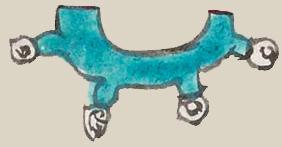apantli (Mdz16r)
This element has been carved from the compound sign for the place name, Teochiapan. It is a flow of water, referring to a canal or waterway (apantli), painted a turquoise blue.
Stephanie Wood
Typical of water signs, this one has alternating droplets or chalchihuitl (round jade stones) and turbinate-shaped shells, splashing off the main flow. Water can take many shapes, but the turquoise color, the indication of currents, and the alternating shells and droplets splashing off, are hallmarks. This visualization of water could possibly intend only the "a" [from atl) and not the "pan" part of the place name locative (both of which are the phonetics provided by apantli in many cases). Apantli (water channels) are typically presented as contained by walls on the sides and bottoms, but not always, as the attestations of apantli will show, below and to the right.
Stephanie Wood
c. 1541, but by 1553 at the latest
Stephanie Wood
water, shells

apan(tli), water channel or canal, https://nahuatl.wired-humanities.org/content/apantli
pan(tli), furrow, https://nahuatl.wired-humanities.org/content/pantli
-apan (locative suffix), on the water, https://nahuatl.wired-humanities.org/content/apan-0
a(tl), water, https://nahuatl.wired-humanities.org/content/atl
-pan (locative suffix), on, https://nahuatl.wired-humanities.org/content/pan
water channel
Stephanie Wood
Codex Mendoza, folio 16 recto, https://digital.bodleian.ox.ac.uk/objects/2fea788e-2aa2-4f08-b6d9-648c00..., image 42 of 188.
The Bodleian Libraries, University of Oxford, hold the original manuscript, the MS. Arch. Selden. A. 1. This image is published here under the UK Creative Commons, “Attribution-NonCommercial-ShareAlike 3.0 License” (CC-BY-NC-SA 3.0).





